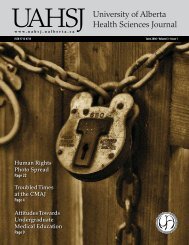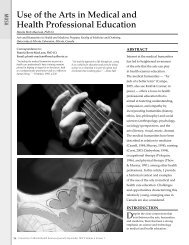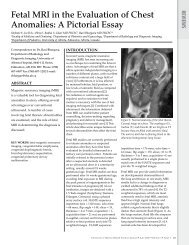REVIEW16. Ji JD, Cheon H, Jun JB, Choi SJ, Kim YR,Lee YH, Kim TH, Chae IJ, Song GG, YooDH, Kim SY, Sohn J. Effects <strong>of</strong> peroxisomeproliferator-activated receptor-gamma(PPAR-gamma) on the expression <strong>of</strong>inflammatory cytokines and apoptosisinduction in rheumatoid synovialfibroblasts and monocytes. J Autoimmun.2001;17(3):215-221.17. Fahmi H, Di Battista JA, Pelletier JP, MineauF, Ranger P, Martel-Pelletier J. Peroxisomeproliferator-activated receptor gammaactivators inhibit interleukin1-beta inducednitric oxide and matrix metalloproteinase13 production in human chondrocytes.Arthritis Rheum. 2001;44:595-607.18. Francois M, Richette P, Tsagris L, et al.Peroxisome proliferator-activated receptorgamma downregulates chondrocyte matrixmetalloproteinase-1 via a novel compositeelement. Clin Exp Immunol. 2002;129:379-384.19. Jiang C, Ting AT, Seed B: PPAR-gammaagonists inhibit production <strong>of</strong> monocyteinflammatory cytokines. Nature 1998;391:82-86.20. Ricote M, Li AC, Wilson TM, Kelly CJ, GlassCK: The peroxisome proliferator-activatedreceptor gamma is a negative regulator<strong>of</strong> macrophage activation. Nature 1998;391:79-82.21. Kobayashi T. Notoya K. Naito T. Unno S.Nakamura A. Martel-Pelletier J. PelletierJP. Pioglitazone, a peroxisome proliferatoractivatedreceptor gamma agonist,reduces the progression <strong>of</strong> experimentalosteoarthritis in guinea pigs. Arthritis &Rheumatism 2005;52(2):479-87.22. Brandt KD, Braunstein EM, Visco DM,O’Connor B, Heck D, Albrecht M Anterior(cranial) cruciate ligament transectionin the dog: a bona fide model <strong>of</strong>osteoarthritis, not merely <strong>of</strong> cartilage injuryand repair. J Rheumatol. 1991;18:436-446.23. Frank CB, Shrive NG, Boorman RS, LoIKY, Hart DA: New perspectives onbioengineering <strong>of</strong> joint tissues: jointadaptation creates a moving target forengineering replacement tissues. AnnBiomed Eng. 2004;32(3):458-465.24. Hashimoto S, Creighton-AchermannL, Takahashi K, Amiel D, Coutts RD,Lotz M. Development and regulation <strong>of</strong>osteophyte formation during experimentalosteoarthritis. Osteoarthritis Cartilage.2002;10:180-187.25. Hellio le Graverand MP, Eggerer J, VignonE, Otterness IG, Braclay L, Hart DA.Assessment <strong>of</strong> specific mRNA levels incartilage regions in a lapine model <strong>of</strong>osteoarthiritis. J Orthop Res. 2002;20:535-544.26. Lohmander, LS, Ostenberg A, EnglundM, Roos H. High prevalence <strong>of</strong> kneeosteoarthritis, pain, and functionallimitations in female soccer players twelveyears after anterior cruciate ligament injury.Arthritis Rheum. 2004;50(10):3145-3152.27. Sah RL, Yang AS, Chen AC, Hant JJ,Halili RB, Yodhioka M, Amiel D, CouttsRD. Physical properties <strong>of</strong> rabbitarticular cartilage after transection <strong>of</strong> theanterior cruciate ligament. J Orthop Res.1997;15:197-203.28. Setton LA, Elliott DM, Mow VC. Alteredmechanics <strong>of</strong> cartilage with osteoarthritis:human osteoarthritis and an experimentalmodel <strong>of</strong> joint degeneration. OsteoarthritisCartilage. 1999;7:2-14.29. Woo S, Young E, Suh J, Engevretsen, L.Acute injury to ligament and meniscusas inducers <strong>of</strong> osteoarthritis. In: KuettnerKE, Goldberg VM, eds. OsteoarthriticDisorders: American Academy <strong>of</strong>Orthopaedic Surgeons, 1995.30. Walsh DA. Pathophysiological mechanisms<strong>of</strong> angiogenesis. Adv Clin Chem.2007;44:187-221.31. Bonnet CS, Walsh DA. Osteoarthritis,angiogenesis and inflammation. JRheumatol. 2005;44(1):7-16.32. Chimich D, et al. Water content altersviscoelastic behaviour <strong>of</strong> the normaladolescent rabbit medial collateralligament. J Biomech. 1992; 25(8):831-837.33. Kobayashi M, Squires GR, Mousa A,Tanzer M, Zukor DJ, Antoniou J, Feige U,Poole AR. Role <strong>of</strong> interleukin-1 and tumornecrosis factor alpha in matrix degradation<strong>of</strong> human osteoarthritic cartilage. ArthritisRheum. 2002;52(1):128-13534. Miller D, Forrester K, Leonard C, Hart DA,Salo P, Bray RC. Endothelial dysfunctionand decreased vascular responsiveness inthe anterior cruciate ligament deficientmodel <strong>of</strong> osteoarthritis. J Appl Physiol.2007;102:1161-1169.Clinical application and review <strong>of</strong> typical and atypicalantipsychotics in the treatment <strong>of</strong> delusional parasitiosisNathan Y. Hoy, 1 Patricia T. Ting, MSc, MD, 2 Stewart Adams, MD 31Faculty <strong>of</strong> Medicine and Dentistry, <strong>University</strong> <strong>of</strong> <strong>Alberta</strong>, Edmonton, Canada2Deparment <strong>of</strong> Dermatology and Cutaneous <strong>Sciences</strong>, Department <strong>of</strong> Medicine, <strong>University</strong> <strong>of</strong> <strong>Alberta</strong>, Edmonton, Canada3Department <strong>of</strong> Dermatology, <strong>University</strong> <strong>of</strong> Calgary, Calgary, CanadaCorrespondence and reprint requests to: Nathan Hoy, #110 Beddington Co-op Mall, 8220 Centre St. N.E.,Calgary, <strong>Alberta</strong>, Canada T3K 1J7, Ph: (780) 289-3383, Fax: (403) 275-1143, Email: nhoy@ualberta.caABSTRACTBackground: Delusional parasitosis (DP)is a monosymptomatic hypochondrialpsychosis characterized by a false beliefthat one is infected with parasites.Traditionally, treatment revolved aroundtypical antipsychotics, especially pimozide.Pimozide’s adverse effect pr<strong>of</strong>ile and theadvent <strong>of</strong> atypical antipsychotics have madethe latter the treatment <strong>of</strong> choice. Given thepaucity <strong>of</strong> randomized control trials andrelatively recent introduction <strong>of</strong> atypicals,little is known about their efficacy in thetreatment <strong>of</strong> DP.Objective: The purpose <strong>of</strong> this study is toreview the evidence for the efficacy and use<strong>of</strong> both typical and atypical antipsychoticsas treatment modalities for DP, with aspecific emphasis on the newer atypicalpharmacologics. As well, we aim to providesuggestions on how best to implementtreatment in a dermatological setting.Methods: Medline and EMBASE weresearched for available literature for both8<strong>University</strong> <strong>of</strong> <strong>Alberta</strong> <strong>Health</strong> <strong>Sciences</strong> <strong>Journal</strong> • April 2012 • Volume 7 • <strong>Issue</strong> 1
types <strong>of</strong> antipsychotics used in the treatment<strong>of</strong> DP. A systematic review was notcompleted to allow for discussion <strong>of</strong> clinicalapplication <strong>of</strong> treatment.Results: Risperidone and olanzapine arecurrently the most commonly used atypicalantipsychotics in DP treatment and areas efficacious as pimozide (full or partialremission rates <strong>of</strong> 68% and 90% respectivelyvs. pimozide average <strong>of</strong> 79%), and havefewer side effects. Other atypicals such asquetiapine, aripiprazole and paliperidoneas well as risperidone long acting injectionshave demonstrated promising remissionrates > 75% in a limited number <strong>of</strong> patients,but still require further studies to beconsidered first-line therapies.Conclusion: Limited clinical studieswith small study populations implicaterisperidone and olanzapine as first linetreatments, but more randomized controltrials are needed. We also review methods<strong>of</strong> how dermatologists may best initiatetreatment with atypical antipsychotics.Keywords: Delusional parasitosis, atypicalantipsychotics, typical antipsychotics,treatmentINTRODUCTIONDelusional parasitosis is amonosymptomatic hypochondrial psychosischaracterized by an unwavering falsebelief that one is infected with parasites. 1Thieberge first described this disorder in1894, and the name delusional parasitosis(DP) was introduced in 1946. 2 Theprevalence <strong>of</strong> DP is not well established,but is considered rare. Overall, the femaleto-maleratio <strong>of</strong> affected individuals isapproximately 2:1, with the mean age <strong>of</strong>diagnosis being slightly higher for femalesthan males (mean age, 50 years to 40 years). 3The classification <strong>of</strong> DP is as either primaryor secondary. Primary DP is characterizedby a somatic delusion lasting for at least1 month, whereby patients do not meetcriterion A for schizophrenia and there canbe no underlying cause <strong>of</strong> the delusion. 4Secondary DP results from the use <strong>of</strong> asubstance, organic causes, or other medicalor psychiatric disorders with the mostcommon causes being schizophrenia,diabetes, depression, cardiovascularevents, and neurodegenerative disease. Acomprehensive review <strong>of</strong> other secondarycauses <strong>of</strong> DP is discussed by Huber et al.(2007). 5Given that DP is a somatic delusion, patients<strong>of</strong>ten initially present to dermatologistsinstead <strong>of</strong> psychiatrists with symptoms <strong>of</strong>pruritis, crawling sensations attributed to thepresence <strong>of</strong> parasites under the skin leadingto secondary excoriations, lichenification,prurigo nodularis and full thicknessulcers. 6, 7 Commonly, patients bring insamples <strong>of</strong> skin in small boxes as pro<strong>of</strong>that the parasites exist; this stereotypicalpresentation is referred to as “the matchboxsign.” 8 Furthermore, patients may attemptto rid these “parasites” with anti-scabeticpermethrin cream or even perform harmfulskin cleansing rituals with disinfectantsor pesticides. 9METHODSTreatment <strong>of</strong> DP requires the differentiationbetween the primary and secondary forms.Treatment <strong>of</strong> secondary DP relies on treatingthe underlying cause or cessation <strong>of</strong> the<strong>of</strong>fending drug. 10 Treatment <strong>of</strong> primary DPhas mostly revolved around typical and thenewer atypical antipsychotics, which havediffering mechanisms <strong>of</strong> action comparedto typical antipsychotics. We conducted aliterature search using combinations <strong>of</strong> thesearch terms: delusion*, parasitosis, typical,atypical, antipsychotics and treatment, inEMBASE and PubMed inclusive <strong>of</strong> studiespublished prior to May 1, 2010. For studiesinvolving typical antipsychotics, only thosewith n≥20 (including placebo group) werereviewed, since these represent the mostinfluential studies on which the basis <strong>of</strong>typical antipsychotic treatment is formed.Due to the relatively recent introduction<strong>of</strong> atypical antipsychotics in the treatment<strong>of</strong> DP, the n values for these studies weresignificantly smaller; thus sample size wasnot used as a definitive exclusion criterion.We included at least one study for eachatypical. The criteria we considered includedthe size <strong>of</strong> the study, with preference beinggiven to larger sample sizes; whether ornot numerous atypicals were comparedwithin the same study, to control for variabletreatment practices; and how well thestudy represented the general treatmentpopulation with respect to disease severity,co-morbidities and age.RESULTSTypical AntipsychoticsThe most common typical antipsychoticused in the treatment <strong>of</strong> DP is pimozide. 11Pimozide is an approved treatment forGilles de la Tourette syndrome in the UnitedStates, but it has also been shown to havea therapeutic effect for numerous <strong>of</strong>flabeldisorders, such as DP. 10-19 Pimozide’sprimary mechanism <strong>of</strong> action is via centralDopamine-receptor D2 antagonism. 12 Oneadvantage <strong>of</strong> pimozide over other typicalantipsychotics is its weak noradrenergicreceptor blockade effect which reducesadverse side effects such as orthostatichypotension and dizziness. 14A number <strong>of</strong> case reports, case series, anddouble-blind crossover trials showingthe effects <strong>of</strong> pimozide in DP have beenconducted (summarized in Table 1) 15-19 .The first double-blind crossover study wasperformed by Hamann and Avnstorp (1982)which demonstrated that 10 out <strong>of</strong> 11 DPpatients had a decrease in Brief PsychiatricRating Scale points and improvement <strong>of</strong>delusion and itching following 6 weeks<strong>of</strong> treatment with pimozide, while onlyone patient from the placebo groupexperienced improvement in the 4 weekevaluation period. 15 In 1986, anotherdouble-blind crossover study showedsignificant improvement in 10 DP patientsadministered 2-8 mg/day <strong>of</strong> pimozide for3 weeks followed by a relapse following 2weeks <strong>of</strong> placebo treatment and subsequentimprovement when pimozide was restarted.Improvement was based on the authors’own rating scale using symptoms <strong>of</strong> DP. 13Although these studies used a placebocontrol, the results are limited by thesmall sample size (i.e. n=11 and n=1013, 15respectively).The rates <strong>of</strong> partial and full remission arevariable amongst studies with pimozide.Zomer et al. (1998) found a partial to fullremission rate <strong>of</strong> 61% (11 out <strong>of</strong> 18 patients)in patients treated with pimozide comparedto 20% (3 out <strong>of</strong> 15) in the non-treatmentgroup. 16 A survey conducted by Lyell (1983)demonstrated 44 <strong>of</strong> 66 patients treatedwith pimozide demonstrated full or partialremission (combined remission rate <strong>of</strong>67%). 17 Partial and full remission <strong>of</strong> DP inpatients treated with pimozide have beenreported as high as 87% (n = 46)18 to 100%(n=10). 13The long-term efficacy <strong>of</strong> treatment withpimozide was demonstrated in a follow-upstudy by Lindskov and Baadsgaard (1985). 19Fourteen patients were followed up between19 and 48 months after termination <strong>of</strong>pimozide treatment. Seven patients hadimproved, while 4 had deterioration <strong>of</strong>their symptoms and 3 had relapses thatresponded well to intermittent pimozidetreatment.A systematic review conducted by Leppinget al. (2007) found a total <strong>of</strong> 92 patientstreated with typical antipsychotics forprimary DP. Of those 92, 40 (43%)had partial remission, 45 (49%) hadfull remission and 7 (8%) showed noimprovement or were lost to follow-up. 10 Ofthe 53 patients treated with pimozide, 50had either full or partial remission (94%),REVIEW<strong>University</strong> <strong>of</strong> <strong>Alberta</strong> <strong>Health</strong> <strong>Sciences</strong> <strong>Journal</strong> • April 2012 • Volume 7 • <strong>Issue</strong> 1 9






